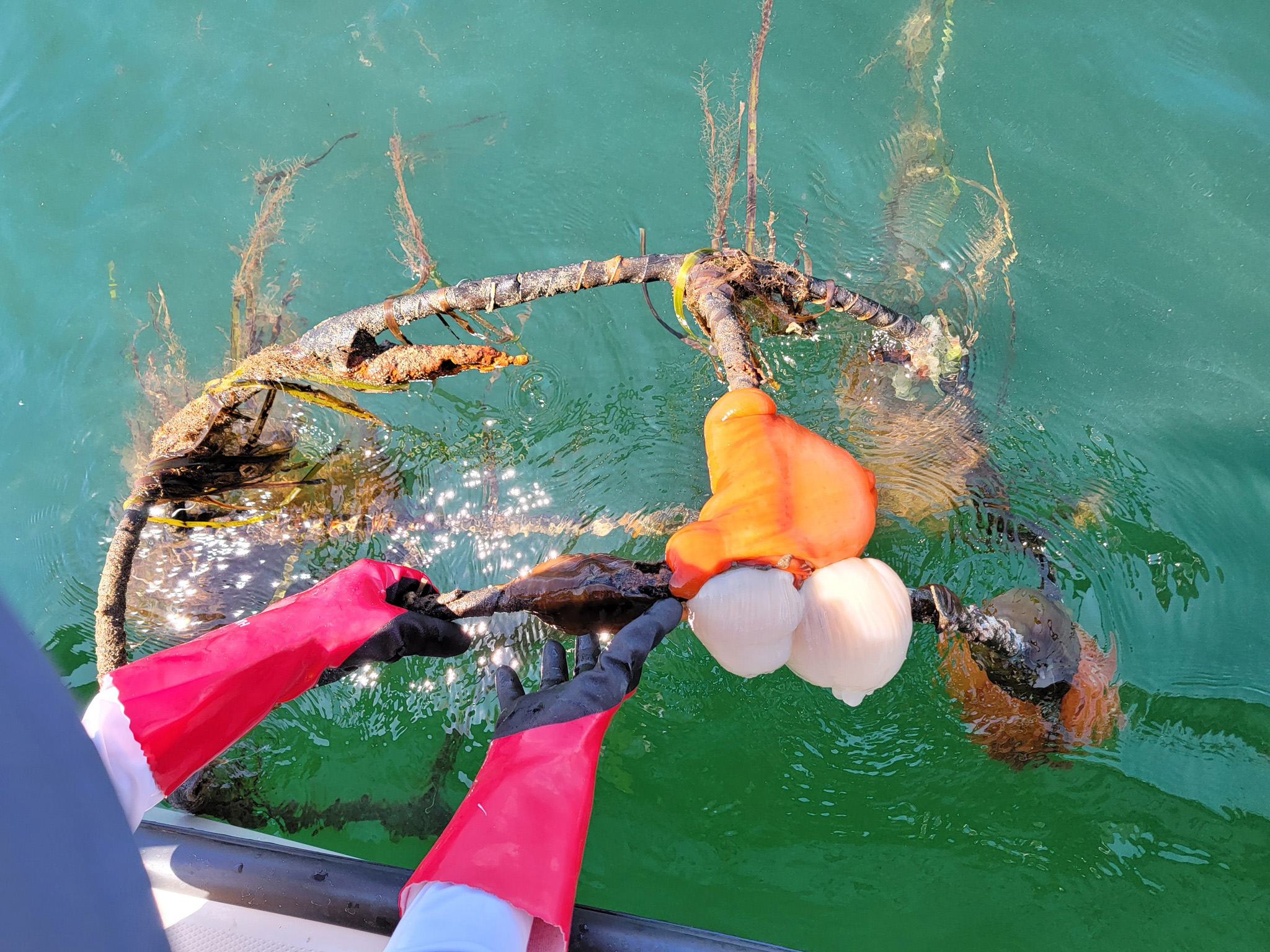Today was my third time out on the boat in barely a week. This summer I’ve been fishing alternately with two different guys, an old friend named Dave and a young coworker named Todd. Today was Todds’s turn to learn all about crabbing. He was a complete neophyte who didn’t even know how to tell a male from a female. As we were just about to hop in the boat and leave, an Everett police officer came up and did a random inspection. He reviewed all of my documents and made sure that I had all of my Coast Guard-required gear. Fortunately everything was in order, but it was a good reminder to keep my ducks in a row.
It was a gorgeous day to be out on Possession Sound. Behind us was some haze that partly obscured the distant mountain peaks, but in front of us the islands were crystal clear and the sea was calm and blue. Last Saturday we had caught lots of crabs off Hat Island but with very few keepers. Today I decided to try our luck closer to Langley. We weren’t fishing this time, so after we set all four pots we had almost an hour to kill. We zipped over to Camano Head and just tooled around doing tight figure eights on the glassy water we found there. Eventually we came back and pulled our first pot an hour after we dropped it. After that we were pretty busy; by the time we got done pulling the last pot and sorting all the crabs it was almost time to pull the first one again. We were having decidedly better luck today.
Every crab pot is a surprise. Two of them held small sea stars. Two of them each had a large keeper-sized crab that was stuck sideways in the escape ring designed to allow smaller crabs to leave, requiring some ingenuity to free it. One pot was weighed down so much that the pot puller groaned and the rope kept slipping. I was worried that it was going to come off the boat. When the pot finally came up, we saw that it was tangled on something huge. It initially looked like an algae-covered log, but we eventually realized that it was a very old derelict crab pot; a big commercial-sized one. The mesh was long gone, so it no longer posed a threat to crabs. It had a whole community of anemones on it, including the biggest giant plumose anemone I’d ever seen. We debated trying to recover the pot to remove litter from the sea floor; however, because of the anemones we decided to drop it again. It had become part of the ecosystem like an old sunken ship.
While our third round was soaking, Todd had requested that we stop at Langley so that he could get a slice of pizza. While I was pulling in to the marina some guy in an aluminum fishing boat was charging right at me and didn’t appear to see me at all. I grabbed my can horn and blew it at him; he changed course right away. As he passed us I could hear a bunch of loud arguing coming from their boat, possibly about the fact that the driver almost hit me.





We pulled each pot three times for a total of 12 pulls, and headed home with seven Dungeness and one red rock. It was plenty. Back at the 10th Street Boat Launch, a couple of young gals from Washington Fish and Wildlife approached us and asked a lot of questions about our crabs, like exactly where we caught them and how we stored them. Then they asked to see our catch record cards, and finally asked to see the crabs themselves to do a biological check. While we worked on transitioning the boat from a graceful water vehicle to an awkward road vehicle, they carefully studied every single one of our crabs and took lots of notes. Unfortunately, they found that two of the crabs were soft shells. I’m not talking about the soft shell crabs served in some restaurants which you can eat whole. I’m talking about a crab which has recently molted and taken on a new, larger shell which hasn’t hardened yet. Their meaty bodies have not yet grown to fill in their new shell, so Fish and Wildlife doesn’t want you to catch them because of the wastage. I apologized, but they assured me that they are biologists and not from Enforcement. They don’t have authority to tell me what to do, but recommended that we return them to the sea. Todd took the job of running down to the fishing pier with a crab in each hand to toss them back in. The women then taught us how to tell a soft shell crab from a hard one by doing a little exam. I thought I was an expert on crabbing by now, but it was interesting to learn that new skill. It was also my second reminder of the day to keep my ducks in a row when boating and fishing.
Discover more from Mini Montauk Adventures
Subscribe to get the latest posts sent to your email.


